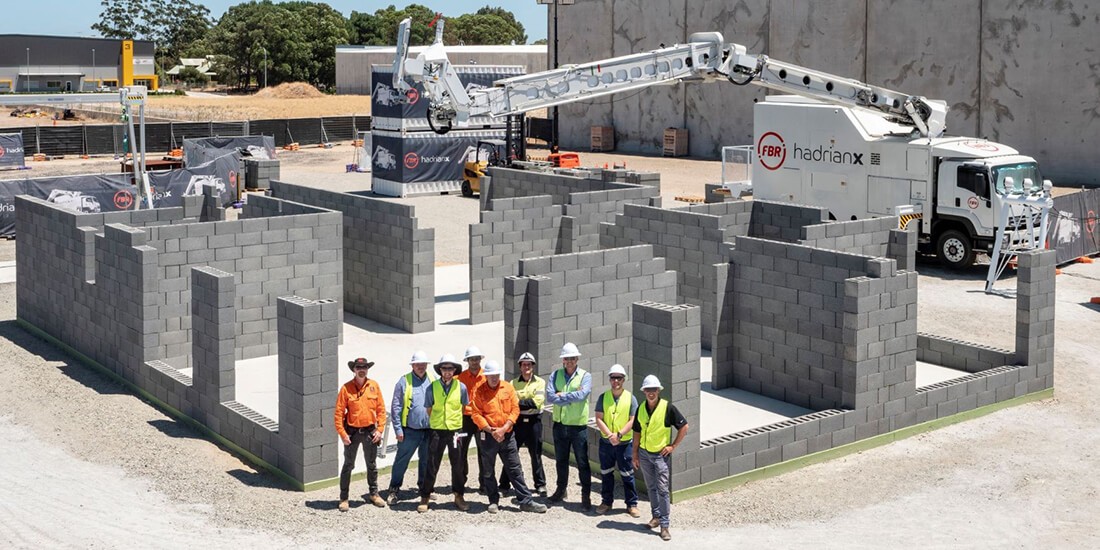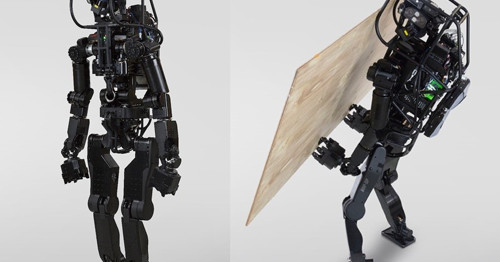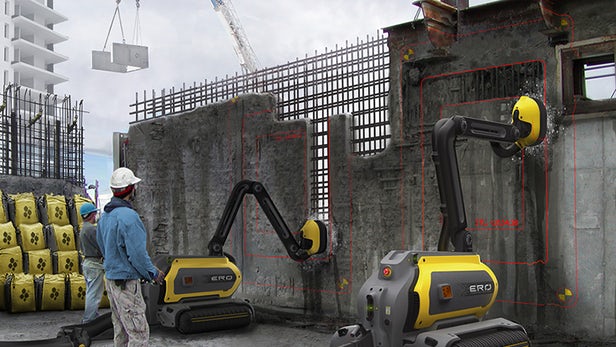How Robots Are Revolutionizing The Construction of Houses and Buildings

Despite the rapid improvement of our intelligent machines, some of the hardest manual work still remains in human hands.
Construction for example – one of the most labor-intensive industries – is also one of the least automated. But with recent advancements in robotics, we could soon see rapid changes on building sites all over the world.
The biggest challenge of using robots in construction is actually not the machinery itself. You may have already seen some of the highly-automated factories around the world (1). Companies have used robotics to transform manual labor into a symphony of mechanical precision. But when it comes to erecting buildings, there's a unique set of challenges that have made it hard for automation to take hold.

Automated robots excel at performing repetitive tasks within a narrow range of variability. Construction work is quite the opposite. Conditions are unpredictable, and there's different tradespeople working on-site throughout the process. Not to mention external factors such as weather and terrain that can change at a moment's notice.
With improvements in engineering and software, we are now seeing robots enter the construction world. And like many industries that have embraced automation, the results are often more than an improvement - they're a quantum leap.
2017 saw the introduction of bricklaying robots, such as the ‘SAM 100’ (2). This semi-autonomous machine can lay bricks faster and with more accuracy than a human worker. And it can do this without ever losing concentration or needing a break. In the same amount of time a human bricklayer can lay 600 bricks, the SAM 100 can lay up to 4,000. And so accurate has it become, the margin for error is now down to mere millimeters.
As impressive as these numbers are, the technology is not without its drawbacks. The machine can only build simple walls in controlled conditions, and with human monitoring. But even on first glance, the potential of the technology is obvious.
Taking this concept a step further, we have the ‘Hadrian X’ from Australian company FBR (3). The Hadrian X (named after a Roman emperor) is a truck-mounted crane that can build an entire house without any human intervention.
Using special concrete bricks which are 12 times larger than normal, the Hadrian X can lay a brick every 50 seconds. Using specialized CAD software, the robot is able to adjust to environmental conditions. “Even with wind blowing and vibration shaking the entire boom, it’s holding that block, compensating hundreds of times a second to keep that block at the precise location,” says Simon Amos of FBR.
After 10 years of development, the Hadrian X built a 180 square-meter home in 3 days during an indoor test. Real-world testing is now underway, and the company has already drawn interest from Mexico, Saudi Arabia, and Austria.
Then, of course, we have 3D printing, which has the potential not only to assist in the construction process - but transform it completely.
Take the example of the tech building company ICON, which 3D printed an entire house in 24 hours at a price of a mere $10,000 (4). ICON’s automated construction robot, named ‘Vulcan’, can 3D print entire homes with almost zero-waste and very little water. With a focus on disaster-relief work, the company already has plans for a 100-home project in El Salvador.
Using the same 3D printing concept, other companies are taking the technology in a different direction. MX3D of Amsterdam has 3D printed a 12-meter stainless-steel bridge (5). Designed and built in a shipping warehouse, the bridge is ready to be installed over a city canal once renovations are complete.
The appeal of robotic construction work also stretches beyond making things faster and cheaper. With automation, there's also improved human safety. Currently, almost 1,000 people die on US constructions sites every year from accidents, falling objects, and machinery. As we’ve already seen in factories and warehouses (6), automation keeps humans out of harm’s way and allows robots to do the heavy lifting.

Construction work is often repetitive, the injury risk is ever-present, and the outdoor environment can be unforgiving. Many countries also face labor shortages and struggle to find skilled workers for existing projects (7).
Automation is the key to solving all these problems and more.
Robots can improve speed and accuracy, increase safety, and reduce costs. They can also eliminate the need for people to work outdoors during blazing summers or freezing winters.
It's likely that in the future, building a house will take only a matter of days and cost a fraction of the current price. Machines will be more efficient, work to a higher standard, and make houses more affordable than ever before.
Without question, robots are set to revolutionalize the entire construction industry.
Picture Credit:
https://newatlas.com/aist-construction-robot-humanoid-hrp-5p/56585/
https://newatlas.com/ero-robot-demolition/28299/
Sources:
(1)https://www.siliconrepublic.com/machines/automated-factories-video
(2)https://www.digitaltrends.com/cool-tech/sam-bricklaying-robot-6x-faster-than-you-can/
(3)https://www.autodesk.com/redshift/bricklaying-robot/
(4)https://singularityhub.com/2018/03/18/this-3d-printed-house-goes-up-in-a-day-for-under-10000/
(5)https://www.dezeen.com/2018/04/17/mx3d-3d-printed-bridge-joris-laarman-arup-amsterdam-netherlands/
(6)https://thebenefitsguide.com/automation-makes-workplace-safer/
(7)http://bruegel.org/2018/01/the-ever-rising-labour-shortages-in-europe/
Thanks for helping to keep our community civil!
This post is an advertisement, or vandalism. It is not useful or relevant to the current topic.
You flagged this as spam. Undo flag.Flag Post


